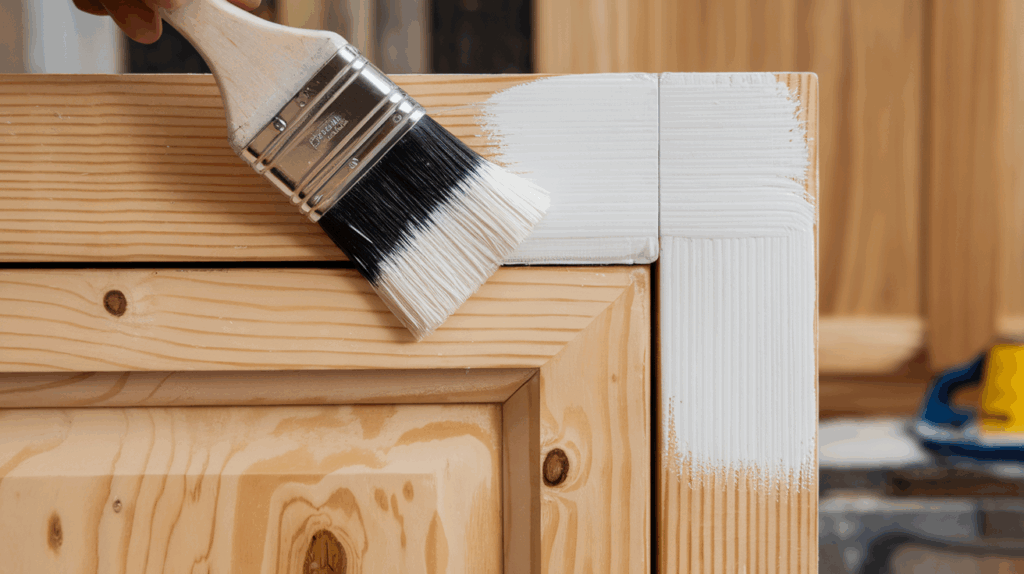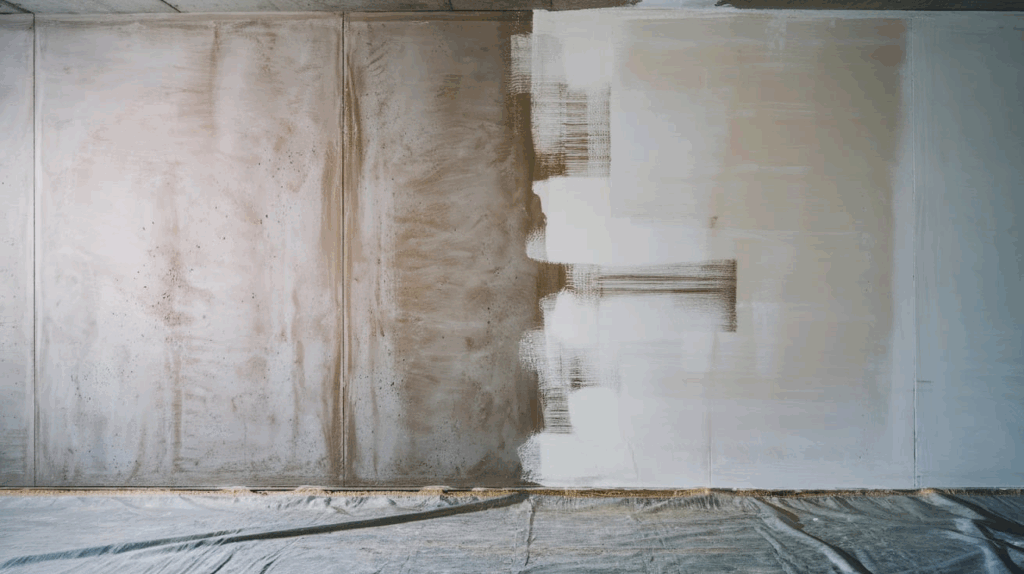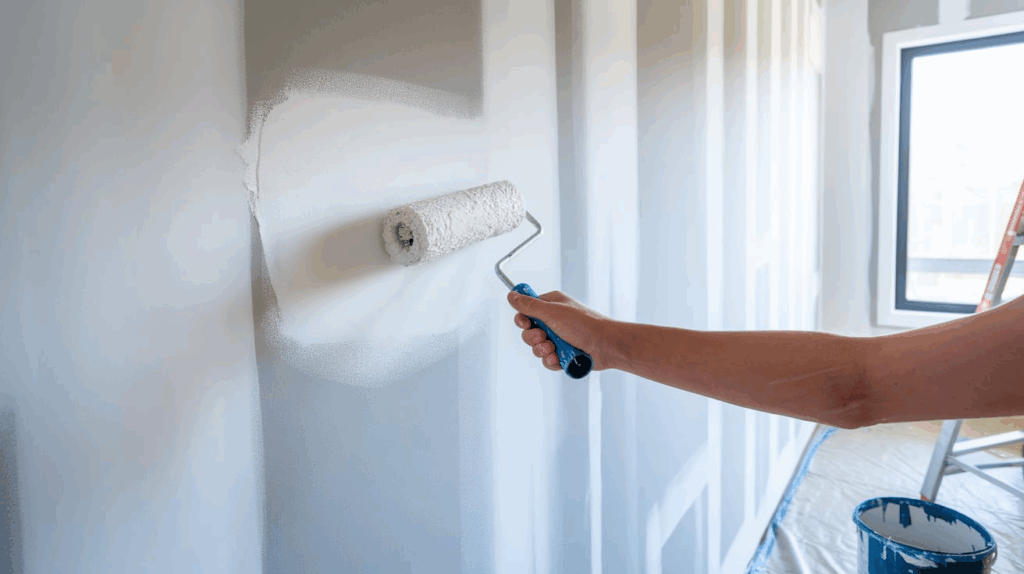Before I paint anything, walls, furniture, or trim I always stop and ask myself: Do I really need to prime?
Priming can feel like an extra step that slows things down, but from experience, skipping it at the wrong time leads to streaky coverage, uneven color, and peeling paint. Not worth it.
In this guide, I’ll break down when primer is essential, when you can skip it, and how to get that smooth, long-lasting finish every time.
If you’re covering dark walls, working with raw materials, or want your paint to last, knowing when to prime makes all the difference.
Let’s walk through it together and make your next paint job one you’re proud of.
Ready to get started? Let’s go.
What Is Paint Primer?

Paint primer is a base coat applied before painting to prepare surfaces and improve the final result. It seals porous materials, blocks stains, and helps paint adhere better and last longer.
Primers are essential for new drywall, bare wood, patched areas, and surfaces with stains or gloss.
They prevent uneven absorption on porous surfaces and provide grip on slick ones. Some primers also block stains, like water marks or smoke damage.
Using primer ensures even coverage, better color accuracy, and improved durability, reducing the need for multiple topcoats.
It helps prevent peeling, cracking, and moisture issues, providing a stable foundation for any paint project.
Where Is Primer Absolutely Necessary?
There are several conditions where primer is essential for proper paint performance. Using it in these scenarios ensures durability, color accuracy, and even application.
1. Bare or Unfinished Surfaces
A primer is necessary on raw drywall, wood, concrete, or plaster because these materials are porous and absorb paint unevenly.
Applying primer seals the surface, fills pores, and creates a consistent base that requires fewer topcoats and enhances paint adhesion for a smoother, longer-lasting finish.
2. Drastic Color Changes
When covering dark or bold paint with a light color, primer helps prevent the old shade from bleeding through.
A tinted primer that matches the new color improves coverage, reduces the number of paint layers needed, and creates a cleaner, more vibrant topcoat without unwanted undertones or patchiness.
3. Stained or Damaged Walls
Walls with water stains, smoke damage, or grease spots need stain-blocking primer to seal in discoloration.
These specially formulated primers prevent stains from resurfacing through paint layers, ensuring the final coat looks clean and uniform, even over previously damaged areas.
4. Glossy or Non-Porous Surfaces
Smooth, shiny materials like glass, tile, and laminate resist paint adhesion.
Bonding primer is designed to stick to these surfaces and allow water-based or latex paint to grip securely. Without primer, the paint may peel, bubble, or fail to bond properly.
5. Switching Paint Types
Painting over oil-based paint with latex requires a bonding primer to ensure adhesion. Latex paint alone won’t stick well to oil-based finishes, leading to peeling or flaking.
Primer creates a stable transition between the two formulas, preventing compatibility issues and improving durability.
6. Patched or Repaired Area
Spots filled with spackle or joint compound absorb paint differently and often appear dull or shiny after drying.
Applying primer to these areas equalizes absorption, blends the finish with the surrounding wall, and eliminates flash spots, resulting in a seamless and professional-looking finish.
When Is It Okay to Go Primer-Free?
Not every painting job requires primer. In some cases, using it may be unnecessary, especially if the surface is already well-prepared or the new paint is close in color and type to the existing one.
1. Repainting Similar Colors
Primer can be skipped when the surface is in good condition and the new color closely matches the existing one.
For example, applying off-white latex paint over a clean, matte beige wall typically doesn’t require a primer coat.
The existing finish already supports adhesion, and the similar shades make full coverage easier.
2. Touch-Ups or Maintenance
Small tasks like freshening up trim, baseboards, or door frames may not require primer, especially if you’re painting over previously sealed surfaces with the same paint type.
If the area is clean, smooth, and undamaged, applying a high-quality topcoat alone is usually enough to restore a neat appearance.
3. Paint and Primer in One
Paint-and-primer-in-one products work well on pre-painted surfaces where the previous color is light and in good shape. They save time on minor updates by combining coverage and adhesion.
However, these products aren’t substitutes for true primers when dealing with bare materials, glossy finishes, heavy stains, or significant color transitions.
Surfaces That Always Need Primer
Some surfaces require a primer to ensure proper paint adhesion, even coverage, and long-term durability. Skipping primer on these can result in peeling, stains, or uneven finishes.
- New Drywall: Highly porous and uneven, new drywall absorbs paint inconsistently. A drywall primer seals the surface, reduces blotchiness, and helps the topcoat go on smoothly with fewer coats.
- Raw or Bare Wood: Wood absorbs paint at different rates depending on grain and moisture content. Knots can bleed through paint. Primer fills pores, seals knots, and prevents tannin stains from showing.
- Bare Metal: Unprimed metal can rust quickly and reject paint. A rust-inhibiting metal primer is essential to protect the surface and promote proper adhesion of the topcoat.
- Glossy or Non-Porous Surfaces: Surfaces like tile, laminate, glass, or previously oil-painted finishes are slick and resist paint. A bonding primer helps the paint grip and prevents peeling or flaking.
- Stained or Damaged Walls: Water stains, smoke residue, and nicotine discoloration will bleed through paint. Stain-blocking primers lock in the stain and stop it from affecting the final finish.
- Concrete, Stucco, or Brick: These are chalky, dusty, and absorbent. Primer seals the surface, prevents moisture loss from paint, and ensures an even, long-lasting finish.
Types of Paint Primers

The right primer depends on the surface type and the issues it presents. Using the correct one ensures better adhesion, smoother finishes, and longer-lasting paint.
1. Latex Primer
Latex primer is a water-based option ideal for drywall, softwoods, and surfaces without stains. It’s low in VOCs, dries quickly, and cleans up easily with soap and water.
While perfect for general prep work on interior walls, it’s not recommended for heavy stains or tannin-rich woods like cedar, where bleed-through is a concern.
2. Oil-Based Primer
Oil-based primers are versatile and highly effective at blocking difficult stains like smoke, water damage, and tannins from wood.
They adhere well to most surfaces, including metal and painted wood, and serve as a bridge between oil and latex topcoats.
However, they release more fumes, take longer to dry, and require mineral spirits for cleanup.
3. Shellac Primer
Shellac primers offer powerful sealing capabilities, making them ideal for covering severe stains, odors, and smoke damage.
They dry quickly and adhere to many surfaces, including wood, metal, and plaster.
Despite their effectiveness, they emit a strong odor during application and need denatured alcohol for cleaning, making ventilation and protective gear necessary during use.
4. Bonding Primer
Bonding primers are engineered for smooth, non-porous surfaces like ceramic tile, PVC, glass, and glossy finishes.
They help paint stick where regular primers would fail, making them essential when switching from oil-based to latex paint or covering slick surfaces.
While often more expensive, bonding primers solve adhesion issues and reduce the risk of peeling or flaking.
What Happens If You Don’t Use Primer?
Skipping primer when it’s needed can lead to a range of problems:
- Peeling or Flaking: Paint may not bond properly, especially on glossy or stained surfaces.
- Uneven Coverage: Bare or patched areas may absorb paint differently, leading to blotchy results.
- Color Bleed-Through: Dark or stained surfaces can show through, requiring more paint or complete repainting.
- Reduced Durability: Paint may wear faster or become damaged by moisture or stains.
The short-term gain of skipping primer can often result in long-term frustration and extra costs from repainting or surface repairs.
Does Paint and Primer in One Work?
Paint-and-primer-in-one products are designed to simplify the painting process by combining two steps into one.
They’re effective on smooth, previously painted surfaces that are clean, dry, and in good condition.
These all-in-one formulas provide decent adhesion and coverage when major surface issues aren’t present.
However, they do not replace true primers in more demanding situations.
They aren’t formulated to seal porous materials like new drywall or bare wood, nor can they effectively block tough stains or odors.
They also struggle to bond on glossy or slick surfaces without extra prep. For those surfaces, a separate primer is still necessary to ensure proper adhesion, stain blocking, and long-term durability.
Conclusion
Primer isn’t something you always need, but when the surface calls for it, trust me, it makes a huge difference.
It helps the paint stick better, gives you more even coverage, and can save you from extra work down the line.
If you’re painting over bare wood, stained walls, or anything glossy, don’t skip the primer.
But if you’re just updating a well-maintained wall with a similar color, you can usually go straight to painting.
Take a few minutes to check your surface before you start. A little prep now can save you hours later.
Need help picking the right primer for your project?
Leave a comment or reach out, I’m happy to help you get started the right way.
Happy painting!
Frequently Asked Questions
Can I use regular paint instead of primer?
No, regular paint lacks the sealing and bonding properties of primer. It won’t perform well on bare, stained, or glossy surfaces.
How many coats of primer do I need?
One coat is usually enough, but porous surfaces, dark colors, or heavy stains may need two coats for full coverage and proper sealing.
Can I tint primer to match my paint color?
Yes, tinting primer helps improve coverage, especially when covering dark walls or switching to bold colors. Most primers can be tinted at the paint store.

